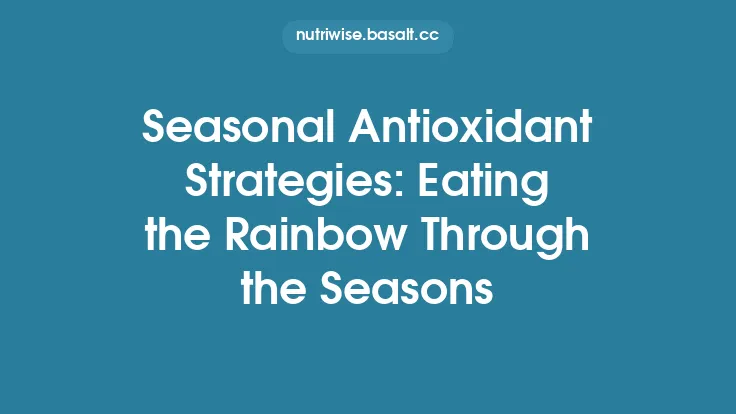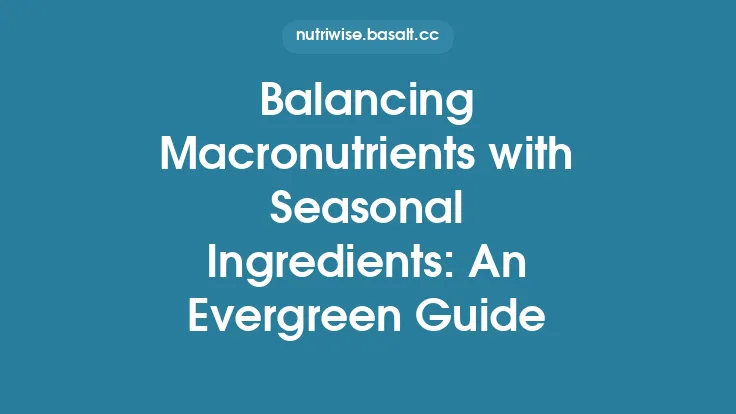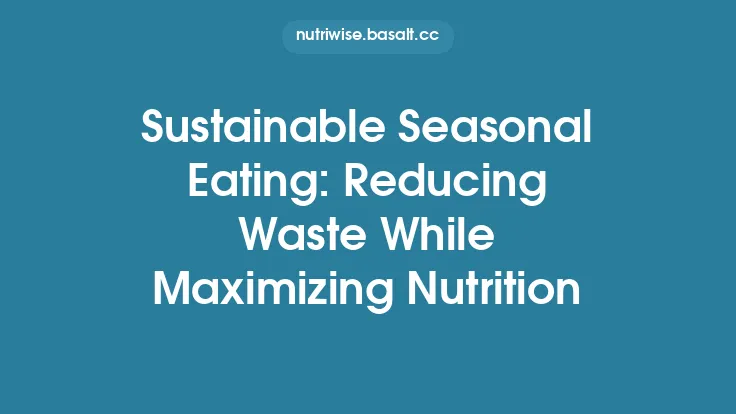Eating with the seasons has been a cornerstone of human nourishment for millennia. Long before supermarkets and global supply chains, communities organized their meals around the natural cadence of the earth, weaving agricultural rhythms into cultural identity, social cohesion, and ecological stewardship. This article explores how those time‑honored practices continue to underpin sustainable health today, drawing connections between cultural tradition, environmental science, nutrition, and socio‑economic resilience.
Cultural Roots of Seasonal Eating
Across continents, seasonal food traditions are embedded in rituals, festivals, and oral histories. In many agrarian societies, the planting and harvest cycles dictate the timing of communal feasts, religious observances, and rites of passage. For example, the Japanese *Oshogatsu (New Year) menu emphasizes foods harvested in late autumn, such as toshikoshi soba, symbolizing longevity and the transition from one year to the next. In the Mediterranean, the Feast of Saint John* celebrates midsummer with dishes that feature freshly gathered herbs and greens, reflecting a cultural reverence for the bounty of the surrounding hills.
These traditions serve multiple functions:
- Temporal Markers: Seasonal dishes act as living calendars, reminding participants of the passage of time and the interdependence between humans and the land.
- Cultural Continuity: Recipes and preparation methods are transmitted across generations, preserving culinary heritage and reinforcing group identity.
- Social Cohesion: Shared meals during seasonal festivals strengthen communal bonds, fostering a sense of belonging that can translate into collective action on environmental issues.
Understanding the cultural scaffolding of seasonal eating provides a framework for why such practices are more than dietary choices—they are expressions of worldview and stewardship.
Ecological Foundations of Seasonal Food Systems
Seasonal food traditions are inherently aligned with the ecological constraints and opportunities of a given region. By consuming what the local ecosystem naturally produces at a particular time, societies minimize the need for artificial inputs such as:
- Energy‑Intensive Transportation: Shorter supply chains reduce fossil fuel consumption and associated greenhouse‑gas emissions.
- Synthetic Fertilizers and Pesticides: Crops grown in their optimal climatic window often require fewer chemical interventions, preserving soil microbiota and water quality.
- Water Resources: Seasonal crops are typically matched to the region’s precipitation patterns, mitigating the demand for irrigation.
From an agroecological perspective, seasonal cropping promotes biodiversity through polyculture and crop rotation. When a community’s diet reflects a rotating palette of species—root vegetables in one period, leafy greens in another, legumes later—farmers can maintain a mosaic of habitats that support pollinators, beneficial insects, and soil organisms. This diversity buffers the system against pests and disease, reducing reliance on monoculture‑driven chemical controls.
Health Implications of Aligning Diet with Natural Rhythms
While the nutritional composition of foods does vary across the year, the health relevance of seasonal eating extends beyond isolated nutrient spikes. Several mechanisms underpin the link between seasonal diets and sustainable health:
- Phytonutrient Optimization: Plants synthesize protective compounds (e.g., flavonoids, carotenoids) in response to environmental stressors such as UV exposure or temperature fluctuations. Consuming produce at the peak of its natural stress response can enhance the intake of these bioactive molecules, which have been associated with anti‑inflammatory and antioxidant effects.
- Gut Microbiome Diversity: A diet that changes with the seasons introduces a broader array of fibers, polyphenols, and micronutrients, fostering a more diverse gut microbiota. Research indicates that microbial diversity correlates with improved metabolic health, immune regulation, and mental well‑being.
- Circadian Synchronization: Seasonal food patterns often coincide with variations in daylight length and temperature, which influence human circadian rhythms. Aligning meal timing and composition with these external cues can improve sleep quality, hormone regulation, and metabolic efficiency.
- Reduced Exposure to Food Additives: Locally sourced, seasonally appropriate foods are less likely to undergo extensive processing, thereby limiting exposure to preservatives, artificial flavors, and excess sodium—factors implicated in chronic disease risk.
Collectively, these pathways illustrate how seasonal choices support a holistic model of health that integrates physiological, microbial, and chronobiological dimensions.
Traditional Knowledge and Modern Science: A Convergence
Indigenous and folk knowledge systems have long recognized the health benefits of seasonal eating, often codified in proverbs, medicinal texts, and culinary manuals. Contemporary research is increasingly validating these observations:
| Traditional Insight | Scientific Correlate |
|---|---|
| “Eat the fruit when it is ripe, not before.” | Post‑harvest ripening increases sugar content and antioxidant capacity. |
| “Cold‑weather greens strengthen the lungs.” | Brassica vegetables grown in cooler temperatures exhibit higher glucosinolate levels, which have respiratory protective properties. |
| “Summer herbs calm the mind.” | Aromatic compounds such as linalool in basil and mint possess anxiolytic effects demonstrated in clinical trials. |
By integrating ethnobotanical surveys with metabolomic profiling, scientists can map the biochemical signatures of seasonally harvested foods, creating a feedback loop that refines both traditional practices and modern dietary guidelines.
Socio‑Economic Dimensions of Seasonal Food Traditions
Seasonal food traditions also shape local economies and food sovereignty:
- Market Resilience: Farmers who align production with seasonal demand can avoid price volatility associated with off‑season imports, stabilizing income streams.
- Value‑Added Cultural Products: Artisanal foods tied to specific festivals—such as fermented dairy in the Andes or spiced breads in the Middle East—command premium prices, supporting small‑scale producers.
- Employment Generation: Seasonal harvests often require labor-intensive practices (hand‑picking, sorting, traditional processing), creating jobs that are culturally relevant and environmentally low‑impact.
Moreover, when communities prioritize locally seasonal foods, they reduce dependence on global commodity markets, enhancing food security in the face of geopolitical disruptions or climate‑induced supply shocks.
Policy and Community Initiatives Supporting Seasonal Practices
Governments and NGOs can reinforce seasonal food traditions through targeted policies:
- Incentivizing Local Production: Tax credits or subsidies for farms that adhere to region‑specific planting calendars encourage sustainable practices.
- Protecting Geographical Indications (GIs): Legal recognition of traditional seasonal products (e.g., “Kalamata olives harvested in early autumn”) safeguards cultural heritage and prevents mislabeling.
- Education Programs: School curricula that incorporate seasonal cooking workshops foster early appreciation for local food cycles and equip youth with practical skills.
- Urban Agriculture Support: Community gardens that follow seasonal planting guides can reconnect city dwellers with rural rhythms, reducing food miles and enhancing mental health.
These interventions create an enabling environment where cultural traditions and modern sustainability goals reinforce each other.
Challenges and Future Directions
Despite the clear benefits, several obstacles impede the broader adoption of seasonal eating:
- Globalized Palates: Consumer expectations for year‑round availability of exotic produce diminish demand for locally seasonal options.
- Supply Chain Constraints: Limited storage infrastructure in some regions hampers the ability to distribute seasonal harvests beyond immediate markets.
- Climate Change: Shifting temperature and precipitation patterns alter phenology, potentially decoupling traditional seasonal calendars from actual crop availability.
Addressing these challenges will require interdisciplinary collaboration:
- Adaptive Agronomy: Breeding programs that maintain genetic diversity while enhancing resilience to altered climatic windows.
- Cold‑Chain Innovation: Energy‑efficient refrigeration and controlled‑atmosphere storage that preserve nutritional quality without compromising sustainability.
- Cultural Revitalization Campaigns: Media and community initiatives that celebrate seasonal dishes, re‑educating consumers about the sensory and health advantages of eating in sync with nature.
By investing in research, infrastructure, and cultural advocacy, societies can safeguard the legacy of seasonal food traditions while evolving them to meet contemporary sustainability imperatives.
Seasonal food traditions embody a convergence of cultural identity, ecological balance, and human health. When we honor the rhythms that have guided our ancestors—through festivals, stories, and the simple act of preparing a meal with what the land offers at that moment—we not only preserve a rich culinary heritage but also lay the groundwork for a more sustainable, resilient, and health‑conscious future.





